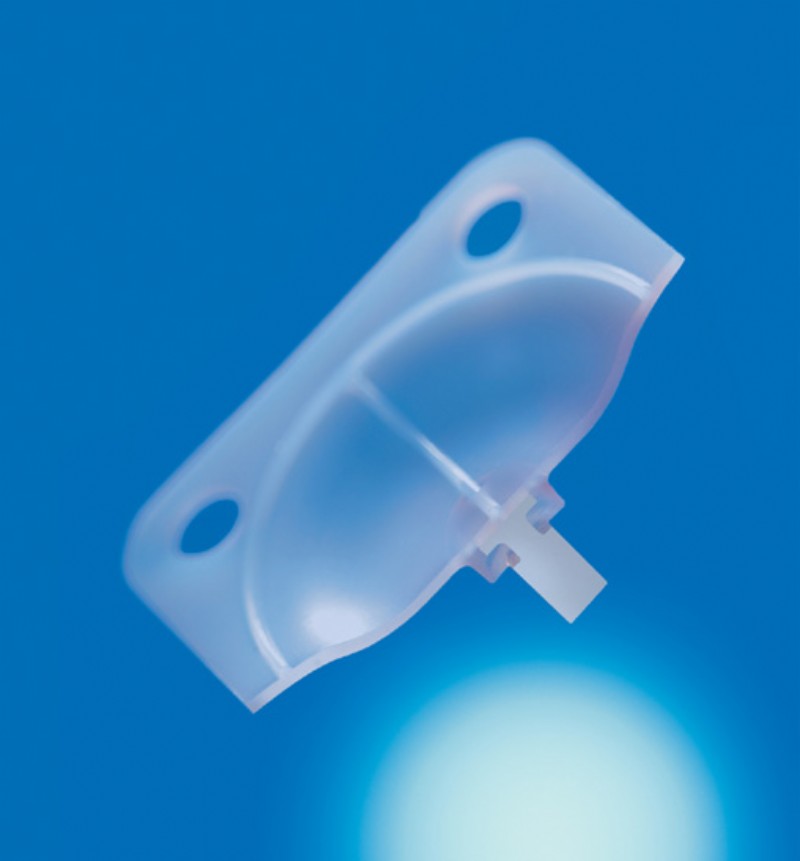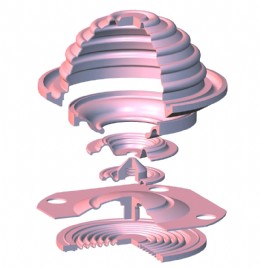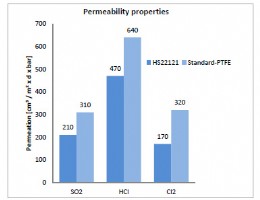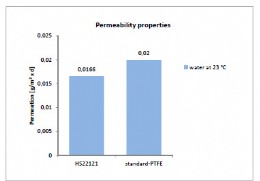PTFE Diaphragms from ElringKlinger Raise the Bar
High-performance PTFE HS 22121—the ideal material for diaphragm seals

Fig. 1: Valve diaphragm made of HS 22121

Fig. 2: Possible designs for PTFE diaphragms

Fig. 3: Reverse bending strength of HS 22121 compares with first & second generation PTFE

Fig. 4: Reduced cold flow of HS 22121

Fig. 5a: Exposed to aggressive chemicals (measurement method: DIN 53380

Fig. 5b: Exposed to water/steam at 23°C

Fig. 5c: Exposed to water/steam at 100°C
Diaphragms are often used in dynamic systems in which they act as a hermetic seal for carrying or separating media. They are generally made of elastomers or elastomers reinforced with woven fabric materials. Chemical, pharmaceutical and food industries primarily make use of PTFE laminated rubber diaphragms in order to exploit the fluoropolymer’s special properties such as chemical resistance, physiological safety, or anti-adhesive behaviour for example. Thermally pressed or machined diaphragms made of HS 22121 (Figure 1) offer an advantage over composite diaphragms owing to their high reverse bending strength, leak tightness and low power input.
Advantages of diaphragms made of fluoropolymers
Diaphragms made of PTFE have a longer service life than those made of a composite materials. When composite materials are subjected to higher pressures and temperature fluctuations, delamination can occur because of the different mechanical properties (Young’s modulus and shear modulus) of each layer which significantly reduces their service life. Depending on their design, PTFE diaphragms can achieve the same mechanical properties as composite membranes made from elastomers and thanks to their high chemical resistance, there are almost no restrictions on their use (FDA/USP 6/3A approval, ATEX directives 94/9/m (European standard EN 13436), etc.).
Machined PTFE diaphragms can be produced more cost effectively and in less time than composite alternatives. Because no special tools are needed, small batch quantities or samples required for testing can be made quickly thereby reducing the number of development loops required.
The advantage of machining is that small and large series parts can be produced under controlled process conditions and without fluctuations in quality.
Figure 2 shows possible design solutions for PTFE diaphragms. This level of design freedom makes it possible to integrate multiple features and functions in the same unit.
Threaded bolts or inserts can be welded or screwed into place for example and these are firmly bonded with the PTFE which allows them to withstand high mechanical stresses in dynamic applications.
Reverse bending strength
What particularly sets PTFE apart is it’s extreme resistance to frequent structural bending. Previously in applications requiring the use of modified PTFE, there were often limitations with regard to the amount of reverse bending which could take place.
With HS 22121, ElringKlinger has succeeded in bringing a material to market that combines the unique properties of various modified PTFE types which is able to surpass the performance of standard PTFE types by a wide margin.
As Figure 3 shows, in HS 22121 ElringKlinger Engineered Plastics has developed a modified PTFE that surpasses previous bending strength values for PTFE by three times in the case of first generation materials and up to ten times that of second generation PTFE.
To determine the reverse bending strength, a test bar with a thickness of 1 mm was bent 180° each time at a frequency of 4 Hz with no media contact.
Reduced cold flow
In addition to high reverse bending resistance, the reduced cold flow of HS 22121 ensures that the diaphragm will remain stable in the clamping area, representing an additional advantage in terms of leak tightness and service life (see Figure 4).
Resistance to permeation
To ensure lasting performance, diaphragms are designed with thin walls. It is therefore all the more important that the material used has a strong barrier effect against permeation.
This is true in the case of modified fluoropolymers and also applies to aggressive chemistry applications using gaseous chemicals such as SO2, HCl, and Cl2 for example. Water presents a challenge for fluoropolymers, particularly at high temperatures in the steam phase (see Figure 5c), or in the form of aqueous aggressive chemicals.
Compared with standard PTFE, the permeation rate can be almost halved through the use of modified PTFE HS 22121, depending on the ambient temperature and medium. Diaphragm walls can thus be made even thinner thanks to the enhanced barrier effect.
Valve diaphragms made of HS 22121 in high-purity applications for the semiconductor industry
Among other applications, HS 22121 is used as a valve diaphragm (see Figure 1) in high purity applications. Here, the advantages of this material over composite diaphragms can be fully exploited. This application calls for material purity, smooth surfaces, and chemical resistance. A surface roughness of Ra = 0.3 μm can easily be maintained.
The structural design minimises dead space and contributes to optimal leak tightness in the system. The high reverse bending strength and permanently welded threaded pin lengthen service life and increase the interval between inspections. In pneumatic control systems, the low power input of the HS 22121 diaphragm also contributes to a reduction in operating costs.
Tel: 01642 492 492 (ext-315)
Email: dave.sampson@elringklinger.com
Web: www.elringklinger-ep.co.uk
Published: 27th March 2018
Rachel Wormald, Managing Director at YPS Valves Ltd and Elizabeth Waterman, ...
Are you looking for industry-leading, brand independent valve and actuator ...
As can be seen from the photograph, clearly the resident birds at Bartlett ...
Howco Group has unveiled its latest £1million investment, with the ...
In 2024, Allvalves is poised for an exciting year of growth and expansion, ...
GMM Pfaudler Engineered Plastics & Gaskets are delighted to bring the ...
In the ever-evolving valve industry, GMM Pfaudler stands out for its ...
SAMSON Controls Ltd – part of the SAMSON group - a renowned leader in ...










